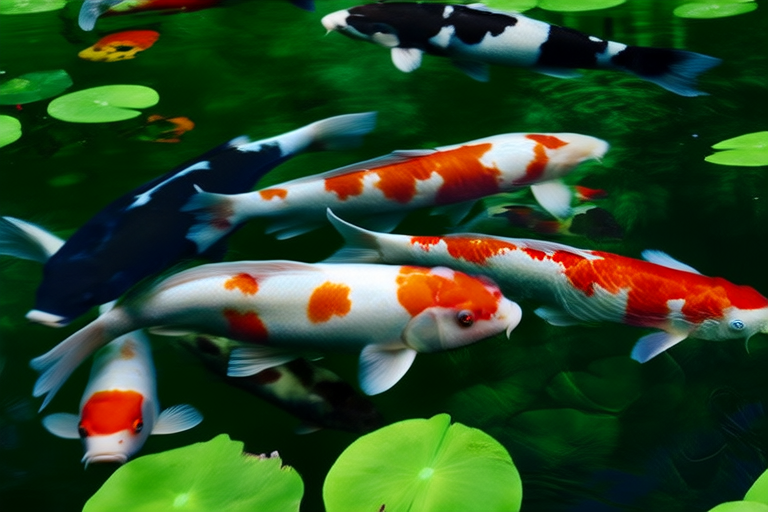Koi Fish: Nature’s Hidden Gems in Your Backyard Pond
Admired for their striking beauty and remarkable resilience, koi fish have captured the hearts of many pond enthusiasts around the world. These elegant aquatic creatures, known scientifically as Cyprinus carpio, have long been cherished for their vibrant colors and graceful movements. Originating from East Asia, koi have evolved from simple food fish to highly prized ornamental pets, bringing elegance and tranquility to backyards everywhere.
The History and Origins of Koi
The story of koi begins in ancient China and Japan, where they were initially valued for their robustness and ability to thrive in various environments. Over time, these fish were selectively bred for their unique patterns and colors, transforming them into symbols of good fortune and prosperity. In Japan, koi became deeply ingrained in cultural traditions, particularly during festivals and celebrations.
From humble beginnings as functional food fish, koi underwent a significant transformation. Japanese breeders refined their breeding techniques, focusing on enhancing the fish’s coloration and patterns. By the early 20th century, koi had become a symbol of luxury and status, adorning ponds in palaces and gardens. Today, koi enthusiasts worldwide appreciate these magnificent creatures not only for their visual appeal but also for their adaptability and hardiness.
Benefits of Keeping Koi in a Backyard Pond
Adding koi to your backyard pond offers numerous benefits beyond mere aesthetics. These fish contribute to a serene environment, enhancing the overall ambiance of your outdoor space. Watching koi gracefully swim through the water can be incredibly soothing, providing a peaceful retreat from the stresses of daily life.
Moreover, koi help maintain the ecological balance within your pond. They consume algae and other organic matter, helping to keep the water clean and clear. Their presence encourages the growth of beneficial bacteria, which further aids in maintaining optimal water conditions. Additionally, koi attract a variety of wildlife, including birds and insects, adding to the natural beauty of your backyard.
Crafting an Ideal Habitat for Koi
Pond Size and Design
To ensure a healthy and thriving environment for your koi, it is essential to create a spacious and well-designed pond. A minimum pond size of 1,000 gallons is recommended for a small group of koi, with additional space required for larger numbers. The depth of the pond should be at least four feet to provide ample swimming room and protection from extreme temperatures.
When designing your pond, consider incorporating gentle slopes and shallow areas, as well as deeper zones for the fish to retreat during hot weather or when startled. Adding ledges or shelves along the sides of the pond provides resting spots for koi and encourages natural behavior.
Filtration Systems
An efficient filtration system is crucial for maintaining water quality in your koi pond. Biological filters promote the growth of beneficial bacteria that break down harmful waste products, while mechanical filters remove debris and particulate matter from the water. Skimmers and UV sterilizers can further enhance water clarity and reduce the risk of disease.
Regular maintenance of your filtration system is vital to ensure its effectiveness. Clean filters, check pump performance, and monitor water parameters to maintain optimal conditions for your koi.
Plant Integration
Incorporating plants into your koi pond offers numerous benefits, including oxygenation, shade, and natural filtration. Floating plants, such as water lilies and lotus, provide cover for koi and absorb excess nutrients from the water. Submerged plants, like hornwort and anacharis, oxygenate the water and offer hiding places for fish.
Emergent plants, such as cattails and iris, add aesthetic value while also providing additional oxygen and filtering pollutants. Carefully select and position plants to maximize their benefits and create a harmonious ecosystem for your koi.
Common Challenges Faced by Koi Owners
Maintaining Water Quality
One of the most critical aspects of koi care is maintaining water quality. Poor water conditions can lead to stress, illness, and even death for your fish. Regular testing of water parameters, such as pH, ammonia, nitrite, and nitrate levels, is essential to ensure a healthy environment.
Invest in a reliable water testing kit and establish a routine for monitoring and adjusting water quality. Regular partial water changes and the use of appropriate treatments can help maintain optimal conditions for your koi.
Preventing Diseases
Despite their resilience, koi are susceptible to various diseases, including fungal infections, bacterial ulcers, and parasitic infestations. Maintaining excellent water quality and providing a balanced diet are key to preventing illnesses.
Observe your koi regularly for signs of distress, such as lethargy, loss of appetite, or unusual behavior. Early detection and treatment of diseases can prevent further complications and save the lives of your fish. Consult with a veterinarian specializing in aquatic animals for guidance on diagnosis and treatment options.
Conclusion: Transform Your Backyard into a Tranquil Oasis
Koi fish are more than just pets; they are living works of art that can transform any backyard into a tranquil oasis. Their vibrant colors, graceful movements, and serene presence make them a delightful addition to any pond. By creating an ideal habitat and addressing common challenges, you can ensure the health and happiness of your koi, providing a peaceful retreat for yourself and visitors alike.
Whether you are a seasoned pond owner or a newcomer to the world of koi, these elegant aquatic creatures offer endless joy and beauty. Embrace the opportunity to bring a piece of nature’s hidden gems into your own backyard and experience the tranquility and wonder of koi fish.
